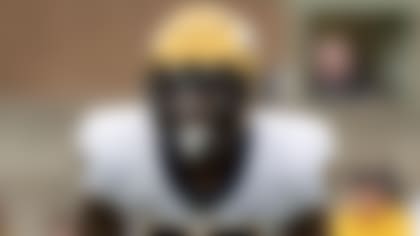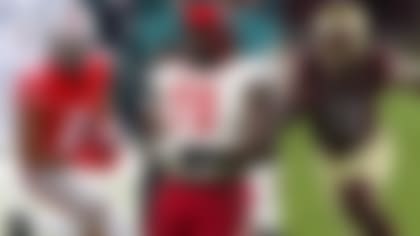With the 2016 NFL Scouting Combine upon us, Bucky Brooks is ranking the top prospects at key positions. Today's focus: quarterbacks.
Pro comparison:Matt Ryan.
Strengths: Polished pocket passer with strong fundamentals and a high football IQ. Goff plays the position like a cagey veteran despite entering the draft after his true junior season. While some scoff at the notion of playing like a "game manager," Goff embraced the efficient approach from the pocket to rack up gaudy numbers as the director of Cal's "Bear Raid" offense. He quickly works through his progressions to get to the second or third option, which allows him to exploit the vulnerable areas of coverage. In addition, Goff will take the swing or checkdown to the running back to prevent opponents from blanketing downfield receivers. From an arm-strength standpoint, Goff rates at a B+ level, but he makes up for this slight shortcoming with superb timing and anticipation. He has a great feel for throwing receivers open and his precise ball placement makes it tough for opponents to disrupt his rhythm as a playmaker. With Goff also showing poise and composure while executing in big moments (two-minute, third-down, red-zone and blitz situations), the Cal standout looks like a Day 1 starter at the position in the NFL.
Weaknesses: Goff's slender frame and arm talent don't scream franchise player at first glance. Skeptics wonder if the 6-foot-4, 215-pounder can withstand the punishment doled out by NFL defenders. Although he was a model of consistency and durability in college, the Cal standout must convince scouts that his sinewy frame can hold up over the course of a pro campaign. From an arm-talent standpoint, few scouts question if Goff can make all of the throws, but the jury is still out on whether his "soft" ball can cut through the wind or inclement weather. Thus, Goff must exhibit enough zip and velocity in drills at Indianapolis and his pro day to put the issue to bed. If he shines as a passer in ideal conditions at the combine, it is hard to imagine the polished player losing his grip on the top QB spot in this class.
Team fits:Cleveland Browns, Dallas Cowboys, San Francisco 49ers, Philadelphia Eagles.
Pro comparison:Cam Newton.
Strengths: Big-bodied quarterback with exceptional arm talent and outstanding movement skills. Wentz is a new-school quarterback capable of killing opponents as a pinpoint pocket passer or as a dual-threat playmaker on the perimeter. Checking in at 6-foot-5, 232 pounds with a rocket arm and nimble feet, Wentz has the talent to blend into any offensive system with ease. He routinely delivers strikes to the boundary (outs and comebacks) from the opposite hash, exhibiting excellent arm strength and velocity on tight-rope throws. Wentz complements his fastball game by displaying a feathery touch on seam passes along the hash or boundary. He routinely drops the ball in between multiple defenders with superb touch and trajectory. As a rusher, Wentz is fearless with the ball in his hands on designed QB runs or zone-read plays. He welcomes contact on the perimeter and doesn't flinch when forced to run between the tackles on quarterback power plays. While QB coaches will cringe at his reckless nature as a runner, Wentz's athleticism and running skills could give a creative offensive coordinator an opportunity to add a dimension to the playbook. Considering Wentz won back-to-back FCS titles while growing into the position -- he didn't start at quarterback for his high school team until senior year -- the Bison star has a chance to be a special player as a pro.
Weaknesses: Scouts have been slow to consider Wentz as a franchise quarterback due to the level of competition he faced in FCS play. Although he certainly didn't appear out of place at the Senior Bowl, the speed and reactions of NFL defenders could surprise him, since he hasn't faced many pro-caliber athletes throughout his career. With Wentz still relatively raw and prone to locking onto his primary receiver, the jump in competition could result in the QB acting as a turnover machine early in his career.
Pro comparison:Carson Palmer.
Strengths: Old-school quarterback with a workmanlike game and winning pedigree. Cook is a gifted game manager capable of taking his game up a notch when needed. He capably makes tight-rope throws to receivers at every level, but also shows the ability to change ball speed and trajectory on touch throws. Cook's arm talent rates at a B+ level, but there are few instances when his lack of zip shows up on tape. He occasionally rips the ball in between multiple defenders to hit an open receiver in a tight window. As a manager, Cook exhibits a strong situational football IQ. He deftly directs the show in critical moments (two-minute, third-down, red-zone and backed-up situations) and his superb ball security (only 22 career interceptions in 43 games) helped him become the winningest quarterback in Spartan history. With most coaches placing a premium on winning over any other trait or characteristic, Cook should rate highly on most boards.
Weaknesses: For all of Cook's success, there are questions about his leadership skills and prickly personality that prevent some scouts from fully buying into his potential as a franchise signal caller. The three-year starter wasn't elected as a team captain by his teammates -- and the snub leads to concerns about his connection with his team. On the field, Cook's accuracy and ball placement are his biggest flaws. He has never finished a season with a completion percentage about 60, which is kind of the Mendoza line for quarterback play. While the vertical nature of the Spartans' offense prevented Cook from padding his stats with layups (bubble screens and quicks), the number of misfires that show up on film lead to legitimate questions about his accuracy on intermediate and deep throws.
Pro comparison:Ryan Tannehill.
Strengths: Ultra-athletic big-bodied passer with rare physical tools. Lynch is an electric dual-threat playmaker capable of delivering explosive plays with his arm or legs. The 6-foot-7, 245-pounder throws the ball to every area of the field with exceptional zip and velocity. He fires fastballs to the boundary from the opposite hash, which suggests he has more than enough arm strength to play at the next level. As a runner, Lynch shows exceptional speed, quickness and power for a man of his size. He routinely runs through contact on the perimeter and flashes the requisite toughness needed to execute designed runs in the red zone. With Lynch also displaying a knack for playing well on the big stage (see: Memphis' win over Ole Miss last October), scouts are intrigued by his developmental potential as a franchise quarterback.
Weaknesses: Lynch's success as a dual-threat playmaker is undeniable, but scouts question whether he can thrive outside of the "pick and stick" system that he directed at Memphis. The Tigers star lived on bubble screens, quicks and "RPOs" (run-pass options), but the quick-rhythm throws don't require the quarterback to make complex reads in the passing game. Thus, he will need plenty of time to acclimate to the pro game and a traditional system that requires him to make full-field or progression reads from the pocket. In addition, Lynch's disappointing play against Auburn in the Birmingham Bowl raised concerns about his ability to thrive against elite competition. While he has enough wins on his résumé to counter that theory, the fact that he struggled mightily against a marginal Auburn defense is certainly troubling for evaluators pegging Lynch as a potential star at the position.
Team fits:San Francisco 49ers, Los Angeles Rams, Houston Texans, New York Jets, Denver Broncos.
Pro comparison:Jay Cutler.
Strengths: Classic dropback passer with a strong arm and prototypical physical dimensions. Hackenberg not only looks like the traditional franchise quarterback, but he flashes the talent and potential to play the position at a high level (see: Hackenberg's freshman season, under the tuteledge of Bill O'Brien). The Penn State product capably makes every throw in the book with zip and velocity, exhibiting A+ arm strength on throws at intermediate and deep range. In addition, he is comfortable executing vertical concepts off traditional dropbacks, as well as play action from under center or in the gun. Thus, offensive coordinators with old-school backgrounds will view him as an ideal developmental prospect simply based off his impressive physical tools. With Hackenberg also showcasing strong leadership traits throughout his time at Penn State, teams could rate him higher than most envision on his scattershot production.
Weaknesses: Despite immense physical tools, Hackenberg is one of the draft's biggest enigmas due to his poor accuracy and questionable judgment. He misses the mark too often on routine throws and his errant passes frequently result in turnovers (31 interceptions in 38 games). Hackenberg's ball-placement woes are exacerbated by his questionable poise and composure under duress. He lacks pocket awareness (feel for rushers in close proximity), which has contributed to his ball-security issues (17 fumbles at PSU). Although Penn State's leaky offensive line forced Hackenberg to take a beating in the pocket, there are countless examples of the quarterback failing to get rid of the ball before the pocket begins crumbling. Given how often NFL quarterbacks are forced to play amid chaos, Hackenberg's inconsistent poise, accuracy and judgment could make him a turnover machine at the next level.
Follow Bucky Brooks on Twitter @BuckyBrooks.












